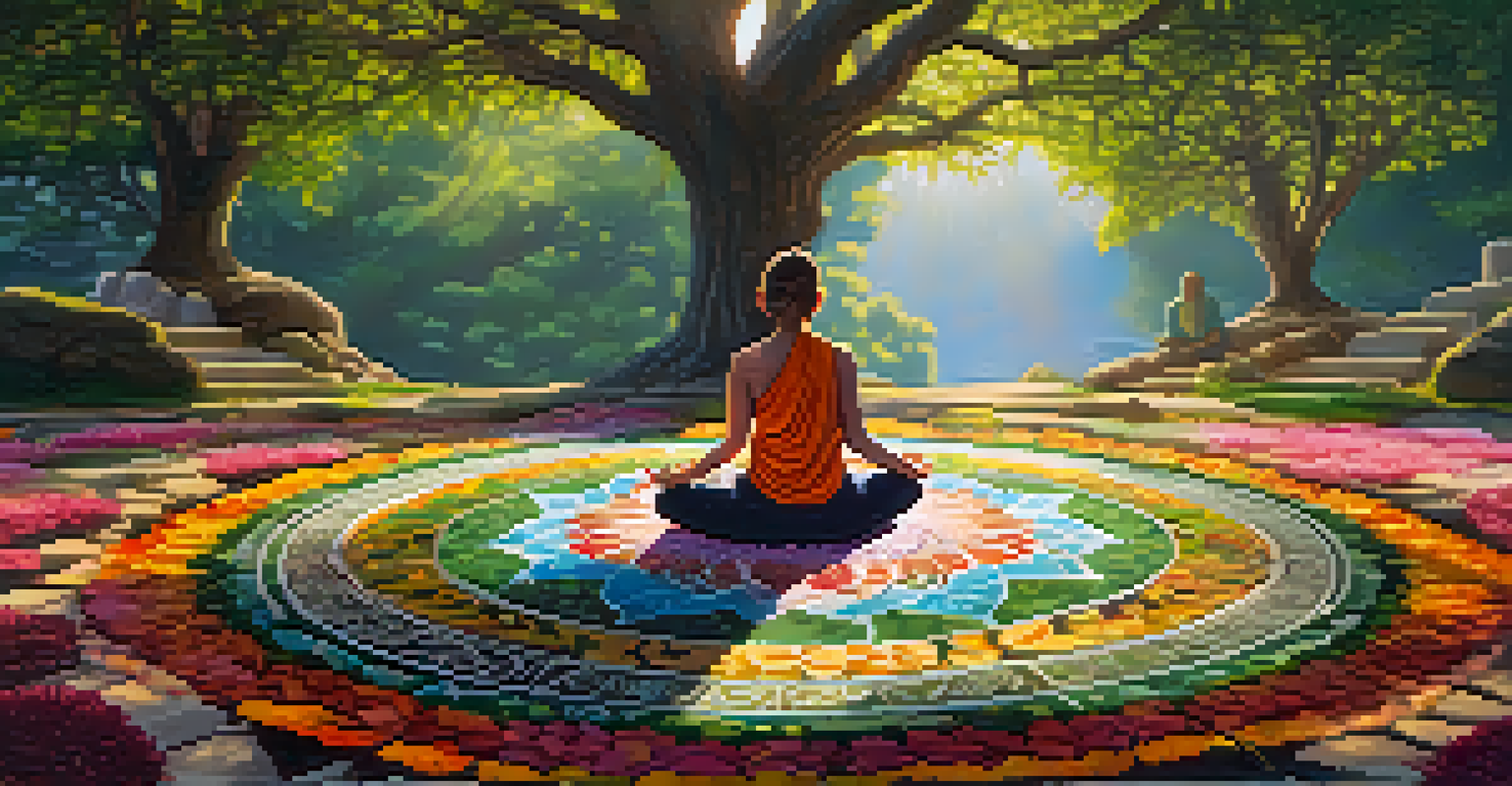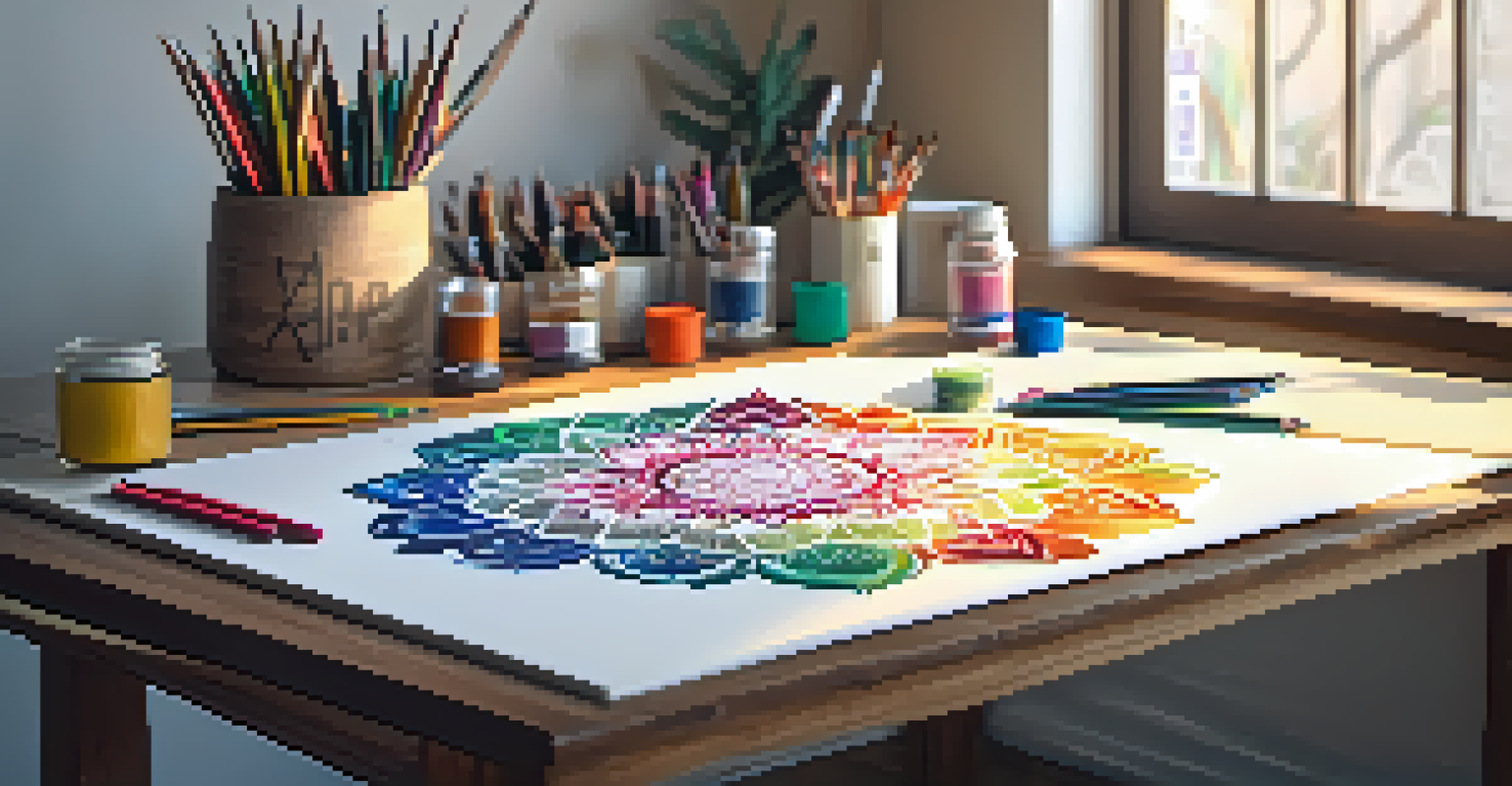Mandala Symbols: Patterns and Their Spiritual Significance

What Are Mandalas and Their Basic Structure?
Mandalas are intricate geometric designs that often represent the universe. Their circular shape symbolizes wholeness and unity, serving as a reminder of the interconnectedness of all life. The patterns within a mandala can vary widely, featuring repeated motifs that create a sense of balance and harmony. Understanding their structure helps us appreciate the deeper meanings they convey.
Mandalas are the cosmic diagrams that remind us of our connection to the universe.
At their core, mandalas can serve various purposes, from art to meditation. When used in meditation, they act as a focal point for the mind, helping to promote inner peace and clarity. Many cultures incorporate mandalas into their spiritual practices, making them a universal symbol of contemplation and reflection.
The beauty of mandalas lies not just in their aesthetic appeal, but in the emotions and thoughts they can evoke. Each shape and color can represent different ideas, feelings, or aspects of life, making the exploration of mandalas a deeply personal journey.
Historical Origins of Mandalas Across Cultures
Mandalas have a rich history that spans multiple cultures and religions, including Hinduism and Buddhism. In these traditions, mandalas are often used as spiritual tools for meditation and visualization. The earliest known mandalas date back to ancient India, where they were drawn as representations of cosmic patterns and divine realms.

In Buddhism, mandalas are used as maps of the universe, guiding practitioners through the complexities of existence. Each element within the mandala carries specific meanings, helping practitioners to focus their intentions and attain enlightenment. This practice underscores the belief that the universe is intricately interconnected.
Mandalas Symbolize Unity and Wholeness
Mandalas are intricate designs representing the universe, embodying the interconnectedness of all life.
Beyond Eastern traditions, mandalas have also found their way into Western culture, often being used in art therapy. They serve as a means of self-expression, allowing individuals to explore their inner thoughts and emotions creatively. This cross-cultural relevance highlights the universal appeal and significance of mandalas in human experience.
Common Mandala Symbols and Their Meanings
Mandalas are rich with symbols, each carrying its own unique meaning. For instance, the lotus flower is a prominent symbol in many mandalas, representing purity and spiritual awakening. As the lotus rises from the mud to bloom beautifully, it embodies the journey of spiritual growth and enlightenment.
Art is the most beautiful of all lies; mandalas are the most truthful of all art.
Other common symbols include the circle, which represents eternity and the cycle of life, while triangles often symbolize balance and harmony. The use of various shapes and colors in mandalas can evoke specific feelings and thoughts, making each mandala a deeply personal reflection of its creator's intentions.
These symbols are not merely decorative; they serve as gateways to deeper understanding. By contemplating these symbols, individuals can explore their personal beliefs, desires, and aspirations, making the practice of creating or observing mandalas a profound spiritual exercise.
The Role of Color in Mandala Patterns
Color plays a crucial role in the creation and interpretation of mandalas. Different colors can evoke distinct emotions and meanings, influencing how we perceive the overall design. For example, blue is often associated with calmness and tranquility, while red can symbolize passion and energy.
When creating a mandala, the choice of color can reflect the creator's mood or intentions. A vibrant, colorful mandala may express joy and creativity, while a more subdued palette might convey serenity and contemplation. This connection between color and emotion adds another layer of depth to the mandala experience.
Mandalas Enhance Mindfulness and Focus
Engaging with mandalas can promote meditation, helping individuals center their thoughts and cultivate mindfulness.
Moreover, the psychological effects of color can enhance the meditative qualities of a mandala. By incorporating specific colors that resonate with their intentions, individuals can create a more personalized and impactful spiritual tool, making the exploration of color in mandalas an engaging and transformative journey.
Mandalas as Tools for Meditation and Mindfulness
Mandalas are often used as powerful tools for meditation, allowing individuals to focus their thoughts and cultivate mindfulness. The act of coloring or creating a mandala can be a meditative practice in itself, helping to center the mind and foster a sense of peace. As one engages with the mandala, they can enter a state of flow, where the outside world fades away.
By concentrating on the intricate patterns, practitioners can enhance their awareness and develop a deeper connection to their inner selves. This process often leads to insights and revelations, as the repetitive nature of working with mandalas can unlock hidden thoughts and feelings.
Incorporating mandalas into daily practice can serve as a reminder to pause and reflect. Whether through coloring, creating, or simply observing, mandalas encourage individuals to embrace the present moment and cultivate a sense of gratitude and mindfulness in their lives.
Creating Your Own Mandala: A Step-by-Step Guide
Creating your own mandala can be a fulfilling and therapeutic experience. Start with a blank canvas, whether it's paper, a digital medium, or even a natural surface like sand. Begin by drawing a simple circle to establish the boundaries of your mandala, allowing you to focus on the central theme you want to express.
Next, incorporate various shapes, patterns, and symbols that resonate with you. There’s no right or wrong way to create a mandala; it’s all about personal expression. As you work, pay attention to your thoughts and emotions, allowing the process to become a form of self-discovery and reflection.
Creating Mandalas Offers Therapeutic Benefits
The process of creating mandalas can reduce stress and anxiety, serving as a powerful tool for emotional expression and healing.
Finally, consider adding color to your mandala, as it can greatly enhance its meaning and emotional impact. Choose colors that speak to you or that align with your intentions. Once completed, take a moment to appreciate your creation and the journey it represents, recognizing that the process is just as important as the final result.
The Therapeutic Benefits of Mandala Art
Engaging with mandala art has been shown to have numerous therapeutic benefits, especially in art therapy settings. The process of creating or coloring mandalas can help reduce stress and anxiety, providing a calming outlet for emotional expression. This creative practice encourages relaxation and mindfulness, making it a valuable tool for mental well-being.
Moreover, working with mandalas can enhance focus and concentration, offering a productive distraction from daily worries. As individuals immerse themselves in the intricate designs, they often find themselves entering a meditative state, which can lead to increased clarity and insight into their thoughts and feelings.

Ultimately, the therapeutic effects of mandala art extend beyond the act of creation. The finished mandala serves as a tangible representation of one’s emotional journey, providing a visual reminder of personal growth and transformation. This makes mandalas not only artistic expressions but also powerful instruments of healing.